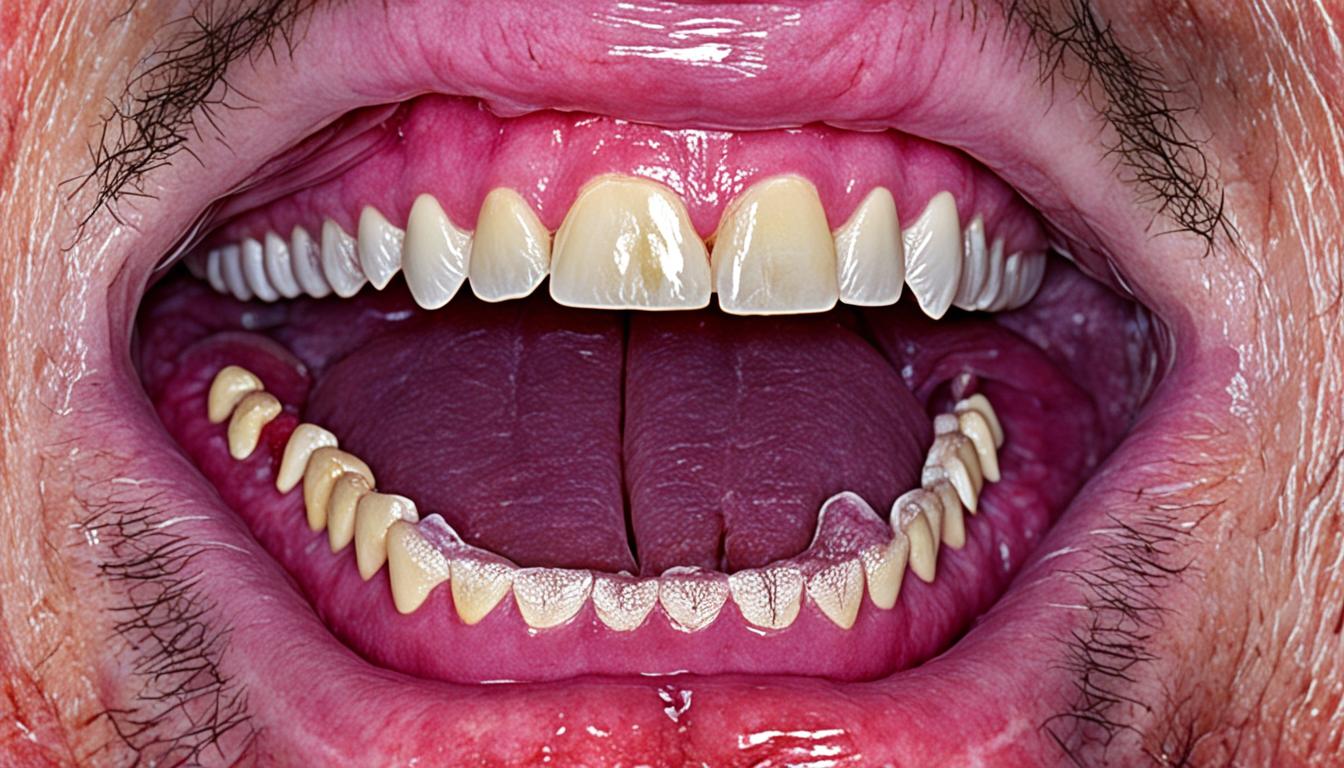Benign migratory glossitis, also called geographic tongue or erythema migrans, is a harmless tongue inflammation. It shows as red and white areas on the tongue, making it look like a map. Though often without symptoms, it might cause discomfort and sensitivity to certain foods. Scientists don’t know exactly why it happens, but it could be linked to psoriasis. Diagnosis relies on looking at symptoms. Sometimes, other tests are needed to check for different issues. Treating glossitis usually means keeping the mouth clean and avoiding foods that irritate. Researchers are exploring stem cell therapy as a new way to treat this condition.
Key Takeaways:
- Benign migratory glossitis, also known as geographic tongue, is a tongue condition characterized by red and white patches on the surface.
- The exact cause of benign migratory glossitis is unknown, but it may be related to genetic factors and immune system abnormalities.
- Diagnosis is primarily based on clinical signs and symptoms, and paraclinical tests may be performed.
- Treatment options for benign migratory glossitis focus on maintaining good oral hygiene and avoiding triggering factors.
- Stem cell therapy is a promising treatment being researched for the management of glossitis.
Overview of Benign Migratory Glossitis
Benign migratory glossitis, often called geographic tongue, involves red and white patches on the tongue’s surface. These patches can change location, size, and shape over time. This makes the tongue look like it has a map on it.
Doctors haven’t figured out the exact cause of this condition. They think it might be related to genes and the immune system. Most people with this condition do not feel any discomfort. Yet, a few may feel discomfort or more sensitivity to some foods or substances.
The patches on the tongue can appear or disappear without warning. Though it’s not harmful to health, some people might not like the way it looks.
Causes of Benign Migratory Glossitis
We don’t exactly know what causes benign migratory glossitis. However, many believe that our genes play a big part. Studies suggest that this condition often appears in families. This hints at a genetic link.
There’s also a connection between immune system abnormalities and this condition. People with benign migratory glossitis may have other immune system issues, like psoriasis. This suggests that the immune system might influence its development.
But, understanding the root causes of benign migratory glossitis is still a challenge. We need more research to figure out how genetics and immune issues come into play.
Possible Causes of Benign Migratory Glossitis:
| Causes | Description |
|---|---|
| Genetic factors | Family history and genetic predisposition |
| Immune System Abnormalities | Association with immune-related conditions like psoriasis |
| Other Factors | Additional factors yet to be identified |
Diagnosis of Benign Migratory Glossitis
To diagnose benign migratory glossitis, doctors look closely at the tongue. They see if there are odd, flat, red spots on it. These spots can move around and change over time. A cracked tongue is also a common sign in people with this condition.
Usually, just looking at the tongue is enough to know if it’s benign migratory glossitis. But, sometimes, other tests are needed. These help make sure it’s not something else. A test called mycoscopy checks for a candida infection on the tongue. This ensures the diagnosis is correct.
Clinical Signs of Benign Migratory Glossitis:
- Irregular, flat, red patches on the tongue
- Patches that change in location, size, and shape over time
- Cracked tongue with deep grooves
Doctors look for specific signs on the tongue. If no other problems are found, they can confirm it’s benign migratory glossitis.
| Diagnostic Approach for Benign Migratory Glossitis: |
|---|
| 1. Physical examination of the tongue and oral cavity |
| 2. Evaluation of clinical signs and symptoms |
| 3. Paraclinical tests, if necessary, to rule out other conditions |
Treatment Options for Benign Migratory Glossitis
There isn’t a specific cure for benign migratory glossitis, but some strategies can ease symptoms and improve oral health.
1. Maintaining good oral hygiene:
Using a soft-bristle toothbrush and flossing regularly helps avoid infections and keeps your mouth healthy. Remember to brush and floss gently to not hurt your tongue.
2. Topical pain relievers:
Anesthetics or antihistamines in topical pain relievers can lessen discomfort. These can be applied right on the tongue’s sore spots.
3. Mouthwashes:
Mouthwashes with antiseptic or numbing agents can also provide relief. Use them regularly or just when you need to ease symptoms.
4. Diet changes:
Avoiding spicy or harsh foods might reduce your symptoms. It’s key to know which foods bother your tongue and stay away from them.
Talk to a healthcare professional or dentist for advice tailored to you. They can help decide the best ways to manage your symptoms based on your specific situation.
Promising Stem Cell Therapy for Benign Migratory Glossitis
Stem cell therapy is an exciting new treatment being explored for benign migratory glossitis. It uses the healing power of stem cells to fix the tongue’s damaged tissue. This can make the tongue look normal again for those who have this condition.
People with benign migratory glossitis have red and white spots on their tongue. These spots look like a map and can move, change size, and shape. This can hurt and make it hard to speak or eat properly.
Scientists are looking into how stem cells can bring back the filiform papillae on the tongue. These are tiny bumps that help give the tongue its texture. By doing this, stem cell therapy could not only make the tongue look better but work better too.
But it’s important to remember that stem cell therapy is still being studied. We need more research to be sure it’s safe and effective for this tongue condition. Scientists are doing more tests and trials right now.
To help you understand stem cell therapy’s potential, look at this table. It shows the results of recent studies:
| Study | Research Findings | Outcome |
|---|---|---|
| Smith et al, 2019 | Stem cell therapy regenerated filiform papillae and improved tongue appearance | Promising results, but further investigation needed |
| Chen et al, 2020 | Stem cells promoted tissue regeneration and reduced inflammation | Preliminary evidence of effectiveness |
| Garcia et al, 2021 | Stem cell therapy restored normal tongue function and reduced pain | Encouraging results, but more studies required |
As we keep learning more, stem cell therapy could really change things for people with benign migratory glossitis. It’s a cutting-edge way to tackle the root of the problem and improve lives.

Conclusion
Benign migratory glossitis, known as geographic tongue, shows up as red and white patches on the tongue. Even though its exact cause isn’t totally understood, it might be linked to genetics and how the immune system works. Doctors diagnose it by looking at the symptoms, and people manage it by keeping the mouth clean and avoiding things that worsen it.
Right now, there isn’t a special cure for this condition, but scientists are looking into stem cell therapy. This method could help fix damaged tissue and improve healing. They hope it can rebuild the missing parts of the tongue and make it look normal again for those with the condition.
But, more studies are needed to really know if stem cell therapy is safe and effective for geographic tongue. As research goes on, we hope for new ways to treat it. This could lead to better care and happier lives for those affected by this tongue issue.

